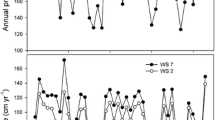Abstract
The objective of this research project is to develop, test, validate, and demonstrate an analytical framework for assessing regional-scale forest disturbance in the mid-Atlantic region by linking forest disturbance and forest nitrogen export to surface waters at multiple spatial scales. It is hypothesized that excessive nitrogen (N) leakage (export) from forested watersheds is a potentially useful, integrative "indicator" of a negative change in forest function which occurs in synchrony with changes in forest structure and species composition. Our research focuses mainly on forest disturbance associated with recent defoliations by the gypsy moth larva (Lymantria dispar) at spatial scales ranging from small watersheds to the entire Chesapeake Bay watershed. An approach for assessing the magnitude of forest disturbance and its impact on surface water quality will be based on an empirical model relating forest N leakage and gypsy moth defoliation that will be calibrated using data from 25 intensively-monitored forested watersheds in the region and tested using data from more than 60 other forested watersheds in Virginia. Ultimately, the model will be extended to the region using spatially-extensive data describing: 1) the spatial distribution of dominant forest types in the mid-Atlantic region based on both remote sensing imagery and plot-scale vegetation data; 2) the spatial pattern of gypsy moth defoliation of forested areas from aerial mapping; and 3) measurements of dissolved N concentrations in streams from synoptic water quality surveys.
Similar content being viewed by others
References
Bicknell, B.R., Donigian, Jr., A.S., Lumb, A.M. and Barnwell, T.O.: 1996, Modeling nitrogen cycling and export in forested watersheds using HSPF, Office of Research and Development, U.S. EPA., Athens, GA.
Bormann, F.H. and Likens, G.E.: 1979, Pattern and Process in a Forested Ecosystem, Springer-Verlag, New York, NY, 253 pp.
Chow, V.T., Maidment, D.R. and Mays, L.W.: 1988, Applied Hydrology, McGraw-Hill Book Co., New York, NY, 572 pp.
Chesapeake Executive Council.: 1989, The first progress report under the 1987 Chesapeake Bay agreement, Chesapeake Executive Council, Richmond, VA.
Church, M.R.: 1989, Direct/delayed response project: future effects of long-term sulfur deposition on surface water chemistry in the northeast and southern Blue Ridge provinces, Vol. I: Executive summary, project approach and data sources, EPA/600/3-89/061a, U.S. EPA, Washington, DC.
DeWalle, D.R. and Pionke, H.B.: 1994, ‘Nitrogen export from forest land in the Chesapeake Bay region’, in: Toward a sustainable watershed: the Chesapeake experiment, Hill P. and Nelson, S. (eds.), Chesapeake Research Consortium Pub. No. 149, Annapolis, MD, pp. 649-655.
Douglass, J.E. and Swank, W.T.: 1975, ‘Effects of management practices on water quality and quantity’, in: Proceedings of the Municipal Watershed Management Symposium, Coweeta Hydrologic Laboratory, North Carolina, USDA Forest Service, Northeastern Experiment Station, Broomall, PA, pp. 1-13.
Dow, C.L.A.: 1992, ‘Sulfur and nitrogen budgets on five forested Appalachian Plateau basins’, M.S. thesis in: Environ. Pollut. Cont., Penn. State Univ., University Park, PA, 132 pp.
Eshleman, K.N.: in review, ‘A linear model of the effects of disturbance on dissolved nitrogen leakage from forested watersheds’, Water Resour. Res.
Eshleman, K.N., Miller-Marshall, L.M. and Webb, J.R.: 1995, ‘Long-term changes in episodic acidification of streams in Shenandoah National Park, Virginia (U.S.A.)’, Water Air Soil Poll. 85, 517-522.
Eshleman, K.N., Morgan II, R.P., Webb, J.R., Deviney, F.A. and Galloway, J.N.: 1998, ‘Temporal patterns of nitrogen leakage from mid-Appalachian forested watersheds: role of defoliation by gypsy moth larvae’, Water Resour. Res. 34, 2005-2016.
Gansner, D.A., Drake, D.A., Arner, S.L., Hershey R.R. and King, S.L.: 1993, Defoliation potential of the gypsy moth, Northeastern Forest Experiment Station Research Note NE-354, USDA Forest Service, Radnor, PA.
Gardner, R.H., Castro, M.S., Morgan, U,R.P. and Seagle, S.W.: 1996, Perspective on Chesapeake Bay: nitrogen dynamics in forested lands of the Chesapeake basin, CRC Pub. No. 151, Chesapeake Research Consortium, Edgewater, MD, 36 pp.
Hansen, M.H., Frieswyk, T., Glover J.F. and Kelly, J.F.: 1997, The eastwide forest inventory data base: user's manual, On-line data base manual: http://www.srsfia.usfs.msstate.edu/ewman.htm.
Hornberger, G.M., Cosby, B.J. and Wright, R.F.: 1987, ‘Analysis of historical surface water acidification in southern Norway using a regionalized conceptual model (MAGIC)’, in: Systems Analysis in Water Quality Management, Beck, M.B. (ed.), Pergamon, New York, pp. 127-132.
Hunsaker, C.T. and Carpenter, D.E.: 1990, Environmental monitoring and assessment program ecological indicators, EPA/600/3-90/060, U.S. Environmental Protection Agency, Research Triangle Park, NC.
Kaufmann, P.R., Herlihy, A.T., Mitch, M.E., Messer, J.J. and Overton, W.S.: 1991, ‘Stream chemistry in the castern United States: 1. Synoptic survey design, acid-base status and regional patterns’, Water Resour. Res. 27, 611-627.
Liebhold, A.M. and Elkinton, J.S.: 1989, ‘Characterizing spatial patterns of gypsy moth regional defoliation’, For. Sci. 35, 557-568.
Lindsey, A.A., Barton, J.D. and Miles, S.R.: 1958, ‘Field efficiencies of forest sampling methods’, Ecology 39, 428-444.
Linker, L.C., Stigall, C.G., Chang, C.H. and Donigian, A.S.: 1996, ‘Aquatic accounting, Chesapeake Bay watershed model quantifies nutrient load’, Water Environ. Technol. Jan. Issue, pp. 48-52.
Paulsen, S.G. et al.: 1991, EMAP surface waters monitoring and research strategy—fiscal year 1991, EPA/600/3-91/022, U.S. Environmental Protrotection Agency, Washington, DC.
Small, M.J. and Sutton, M.C.: 1986, ‘A direct distribution model for regional aquatic acidification’, Water Resour. Res. 22, 1749-1758.
Swank, W.T.: 1988, ‘Stream chemistry responses to disturbance’, in: Forest Hydrology and Ecology at Coweeta, Swank, W.T. and Crossley, Jr., D.A. (eds.), Springer-Verlag, New York, NY, pp. 339-357.
Webb, J.R., Deviney, F.A., Galloway, J.N., Rinehart, C.A., Thompson, P.A. and Wilson, S.: 1994, The acid-base status of native brook trout streams in the mountains of Virginia, Dept. of Environ. Sciences, Univ. of Virginia, unpublished report.
Webb, J.R., Cosby, B.J., Deviney, Jr., F.A., Eshleman, K.N. and Galloway, J.N.: 1995, ‘Change in the acid-base status of an Appalachian Mountain catchment following forest defoliation by the gypsy moth’, Water Air Soil Poll. 85, 535-540.
Author information
Authors and Affiliations
Rights and permissions
About this article
Cite this article
Eshleman, K.N., Gardner, R.H., Seagle, S.W. et al. Effects of Disturbance on Nitrogen Export from Forested Lands of the Chesapeake Bay Watershed. Environ Monit Assess 63, 187–197 (2000). https://doi.org/10.1023/A:1006427401665
Issue Date:
DOI: https://doi.org/10.1023/A:1006427401665




